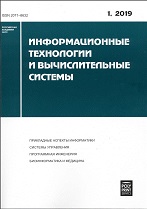|
This article is cited in 4 scientific papers (total in 4 papers)
PATTERN RECOGNITION
Dynamic programming approach to textual structured objects segmentation in images
M. A. Povolotskiyabc, D. V. Tropinca, T. S. Chernovc, B. I. Savelyevc
a Moscow Institute of Physics and Technology (State University), Dolgoprudny, Russia
b The Institute for Information Transmission Problems of the Russian Academy of Sciences (Kharkevich Institute), Moscow, Russia
c Smart Engines Service, Moscow, Russia
Abstract:
This paper deals with the problem of segmentation of images of text fragments with known constraints on the relative position of elements. The model in which the constraints form a path graph is considered. It is shown that the segmentation problem in this case can be solved precisely with use of a dynamic programming algorithm, and this algorithm has an optimal asymptotic complexity. This algorithm was built into two recognition systems. The first system was designed to recognize identity documents, such as passports and driver's licenses. The proposed algorithm was used in this system to extract information fields. To do this, a two-level field hierarchy was introduced, in which the fields were grouped in rows, within which they were ordered from left to right, and the lines themselves were ordered from top to bottom. The second system was designed to recognize license plates in which the proposed algorithm was used to segment plates into individual characters. In this case, the natural ordering of characters from left to right was introduced. Thus, the generality of the proposed approach is demonstrated. Experiments were conducted on a closed data set to measure the quality and performance of the solutions obtained on a mobile phone. Experimental results showed that the solutions obtained are superior in quality to algorithms that do not use constraints on the mutual arrangement of elements, and their complexity allows them to work on mobile devices in real time.
Keywords:
text segmentation, dynamic programming, document recognition, image processing, OCR.
Citation:
M. A. Povolotskiy, D. V. Tropin, T. S. Chernov, B. I. Savelyev, “Dynamic programming approach to textual structured objects segmentation in images”, Informatsionnye Tekhnologii i Vychslitel'nye Sistemy, 2019, no. 3, 66–78
Linking options:
https://www.mathnet.ru/eng/itvs354 https://www.mathnet.ru/eng/itvs/y2019/i3/p66
|

| Statistics & downloads: |
| Abstract page: | 184 | | Full-text PDF : | 250 | | References: | 1 |
|




 Contact us:
Contact us: Terms of Use
Terms of Use
 Registration to the website
Registration to the website Logotypes
Logotypes









 Citation in format
Citation in format 
